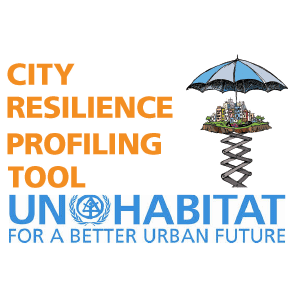City Resilience Profiling Tool
The City Resilience Profiling Tool (CRPT) is a self-assessment tool primarily addressed to municipal leaders, managers, urban planners, and other personnel with a responsibility for ensuring the safety, maintenance, and security of all aspects and functions of an urban area, including critical infrastructure and services, health facilities, transport and telecommunications networks, sanitation, water, etc.
The City Resilience Profiling Programme (CRPP) of UN-Habitat, in response to local government and stakeholder demands, designs this tool for generating metrics for urban resilience in order to establish baselines (or ‘profiles’) upon which to integrate resilience based inputs to sustainable urban planning, development, and management processes in cities and other human settlements throughout the world. The main goal of the CRPP is to support local governments and their stakeholders by transforming urban areas into safer and better places to live in, and improve their capacity to absorb and rebound quickly to any and all potential shocks or stresses.
The tool is applicable to any human settlement regardless of size, culture, geography or economy. It must produce validated, ‘auditable’ data reducing ambiguity and informing planning, development and management decision-making. To achieve this goal the tool is built upon an universal model of an urban system developed by CRPP integrating all elements of urban systems organized along five key axis common to any urban area. The five axes include ubiquitous descriptors common to all cities namely all human settlements have physical (built) aspects; functional elements; organizational structures, and a spatial dimension. The fifth axis -'time' describes the dynamic of the urban system.
The five apex elements contain a wide array of ‘attributes’ that define the city system in terms of:
Physical attributes - from dwellings, and unpaved village roads; to the complex built environment of mega-cities.
Functional attributes - describing processes and flows – again anything from a rural village market and transport hub, to commercial, governance, and social processes in large cities.
Spatial attributes – all human settlements are located somewhere geographically, and for better or worse, distributed in specific spatial terms from the smallest plot up through urban segments, to peri-urban, district; national and international locations.
Organizational attributes – here meaning any association of humans for some purpose – formal, informal, corporate or political, and can describe any organizational scale from an individual, to a neighborhood or community association, or a council of elders, to rate-payers groups, or even professional or religious associations that can influence the profile of the city, and more formal institutions such as local, regional or national governments.
Time – the fifth element is the understanding that cities are not static, and evolve continuously.
The implementation of the tool in cities is the first step in the CRPP methodology that allows gathering information from a multi-dimensional and multi-stakeholder approach, evaluating it and producing the resilience profile of the city that sets the guidelines for further developing the Resilience Action Plan that will be integrated into the urban planning development of the city.
More information about urban resilience can be gound at Urban Resilience Hub (hosted by UN-Habitat).

